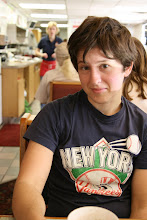 Read a fantastic book by Geoffrey Batchen yesterday called Forget Me Not, and here are some of my favorite parts below. The photograph is is a large-format negative in my collection, one side is of the object lit from the front, the other lit from the back.
Read a fantastic book by Geoffrey Batchen yesterday called Forget Me Not, and here are some of my favorite parts below. The photograph is is a large-format negative in my collection, one side is of the object lit from the front, the other lit from the back.In this practice, the photograph is treated as a tangible metaphor, as something one looks at rather then through, as an opaque icon whose significance rests on a ritual rather than on visual truth. While the photograph usually speaks to us of the past, of the time when the photograph was taken, the fotoescultura occupies an ongoing present. While the photograph speaks of death, of time's passing, the fotoescultura speaks of eternal life, suggesting the possibility of a perpetual stasis, the fully dimensioned presence of the present (64).
As a footprint is to a foot, so a photograph is to its referent. Photographs are, scholars have suggested, "physical traces of their objects, " "somethings directly stenciled off the real," even "a kind of deposit of the real itself."
Barthes makes much of the physicality of photography's connection to its subject. "The photograph is literally an emanation of the referent. From a real body, which was there, proceed radiations which ultimately touch me, who am here... a sort of umbilical cord links the body of the photographed thing to my gaze." (74)
The photograph in my locket was presumably thought to lack something that the addition of hair supplied; but it would appear that the hair alone was also deemed to be not enough-- apparently, neither was fully effective as an act of representation without the presence of the other. Like a photograph, the hair sample recalls the body of the absent subject, turning the locket into a modern fetish object; as a mode of representation, it "allow[s] me to believe that what is missing is present all the same, even though I know it is not the case." (75-76)
Both Plato and Freud use the image of a tablet of wax to describe the operations of memory. In their descriptions, the pristine surface of a wax tablet must be ruined, marked by impressions of "perceptions and thoughts," in order to function as a memory apparatus. The tablet can never actually have been pristine, of course-- for how could we remember something unless some trace were already there, unless the wax had already been shaped or marked in a moment now being recalled?... For memory is always in a state of ruin; to remember something is already to have ruined it, to have displaced it from its moment of origin. Memory is caught in a conundrum-- the passing of time that makes memory possible and necessary is also what makes memory fade and die. (77-78)
Something must be done to the photograph to pull it (and us) out of the past and into the present. (94)
Photography is usually about making things visible, but these elaborated photographs are equally dedicated to the evocation of the invible-- relationships, emotions, memories. They affirm the close proximity of life and death, and attempt, against common sense, to use one to deny the finality of the other. (96)
Memory, to borrow the words of Roland Barthes, is posited here as both artifice and reality, something perceived, invented, and projected, all at once: "whether or not it is triggered, it is an addition: it is what I add to the photograph and what is nonetheless already there." (97)
One's sense of self, of identity, is buttressed by such objects...In the case of hybrid photographies, for example, individual identity is posited not as fixed and autonomous but as dynamic and collective, as a continual process of becoming. Perhaps this is why these artifacts offer such a powerful experience. Complex object-forms devoted to the cult of remembrance, these photographies ask us to surrender something of ourselves, if they are to function satisfactorily. They demand the projection onto their constituent stuff of our own bodies, but also of our personal recolections, hopes, and fears-- fears of the passing of time, of death, of being remembered only as history, and, most disturbing, of not being remembered as all. (97-98)

No comments:
Post a Comment